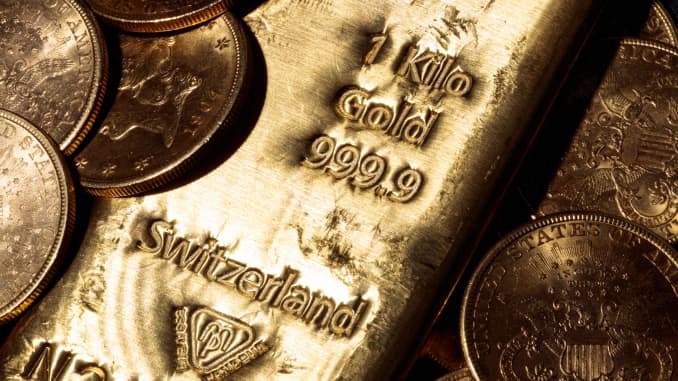- The precious metal was trading at just below $1,670 on Friday, having a few weeks ago surpassed $1,688.60 to hit its highest level since the start of 2013.
- As demand rises, networks of scammers, who pose as legitimate gold traders and attempt to dupe investors, are evolving their tactics, while counterfeit products are becoming ever more advanced.

A one kilo Swiss gold bar and US dollars gold coins are pictured in Paris on February 20, 2020.
The price of gold spiked again this week as investors sought surety amid concerns over the coronavirus outbreak, but scammers are also capitalizing on the surge.
The precious metal was trading at just below $1,670 on Friday, having a few weeks ago surpassed $1,688.60 to hit its highest level since the start of 2013.
But as demand continues to rise, networks of scammers, who pose as legitimate gold traders and attempt to dupe investors, are evolving their tactics, according to experts, while counterfeit products are becoming ever more advanced.
“We are just starting to see an increase in fraudulent approaches reported by clients,” Rick Rule, CEO of asset manager Sprott, told CNBC via email.
“These always coincide with an increase in precious metals prices, which usually itself coincides with times when fear of more conventional investment products is high.”
Types of scams
Rule added that increasingly, these approaches are being made via the internet.
“Hyperbolic articles about the upside available in precious metals generate interest, with the inbound investor inquiries swindled in numerous ways, including off-market products, excessive spreads, or simple swindles where the customer forwards money for goods that are never transferred, or delivered,” he explained.
Adrian Ash, director of research at online gold and silver market BullionVault, said the last bull run of this magnitude for gold around a decade ago unleashed a plethora of scammers. The most basic form, Ash told CNBC last week, was scammers misrepresenting standard gold bullion coins as rare and overcharging unwitting investors.
Another is the “empty vault” method, in which the dealer promises to provide safe storage for metal owned by the investor which either does not exist or is not as promoted.
“If someone is looking after something for you, how do you know it’s there? If you go to inspect it, how do you know it belongs to you and how do you know it doesn’t belong to 20 other people?” Ash said.

WATCH NOWVIDEO01:33A big jump in the price of gold means a jump in gold-related scams.
One way companies can get around this, Ash suggested, is to issue daily public holdings data, in which each investor can see a list of anonymous nicknames and their holdings, thus checking that everything is in order without surrendering their privacy. BullionVault also sends independent reviewers to vaults to check that each gold bar is as described.
Ken Lewis, CEO of OneGold, a joint project between Sprott and precious metals dealer APMEX, flagged the diverse range of methods used to target potential investors.
“In 2019, we had what they call a ‘mule’ ring. The extent of this was individuals would be lured in through dating site applications where the scammer would ask a person to order gold and, subsequently, have them forward the gold to the scammer all under the impression that the gold is needed to help the individual get to the U.S.,” he told CNBC.
Lewis estimated that this scam totaled between $3 million and $5 million and affected hundreds of investors.
It is also common for scammers to offer counterfeit gold below the market rate on online marketplaces. These fakes are becoming increasingly advanced and unless the customer has the gold properly tested, they may be unaware of its inauthenticity until they try to sell it on.
Lewis advised that the easiest way to identify genuine products was to study its weight and dimensions.
“Gold is one of the densest elements, with only a few rare metals … with higher densities. If the weight and dimensions of the gold product match the manufacturer’s specifications, it is likely that the product is authentic,” he explained.
Lewis also highlighted the use of infomercials, which encourage potential investors to call in. These often vulnerable or elderly investors are then pitched a product that is vastly overpriced, with high pressure sales techniques and promises of exponential growth.
Targets
Gold scams often play on affinity, with scammers establishing “trust based” communications with victims, according to Rule.
“The connections can be politically or socially based, as people who are attracted to gold investing are often politically conservative. Ethnic and religious connections were also commonly exploited, in the 1970s gold boom,” he said.
Many scams, Rule suggested, have revolved around the gold buyer’s desire to avoid reporting and taxation, with promises of anonymity proving an effective tool for those looking to prey on gold investors. Anonymous or offshore storage options are often offered but do not exist.
Protect yourself
Gold experts advise that the best way to avoid being scammed is to deal only with reputable, established dealers. Brokers’ licenses can be verified via the Financial Industry Regulatory Authority (FINRA) website, and online reviews can be examined.
“Look for dealers in commonly accepted products, like sovereign-issued bullion coins, or commonly hallmarked bullion products,” Rule said.
“Importantly, insist on well-established storage arrangements. Beware of ‘off market’ products.”